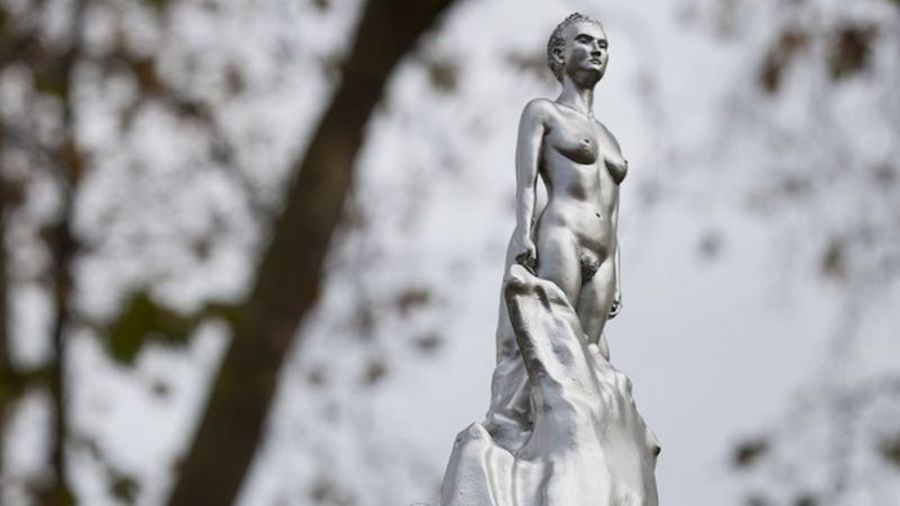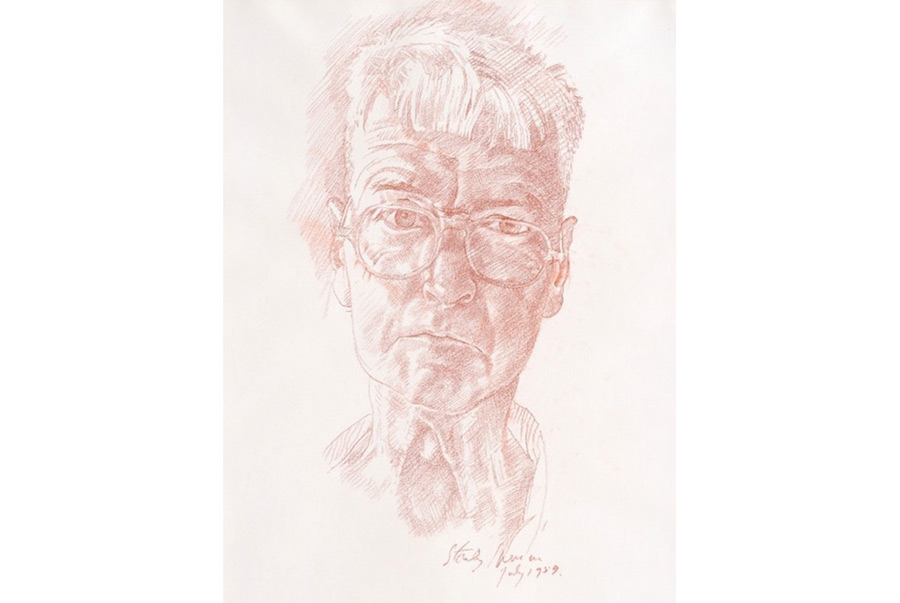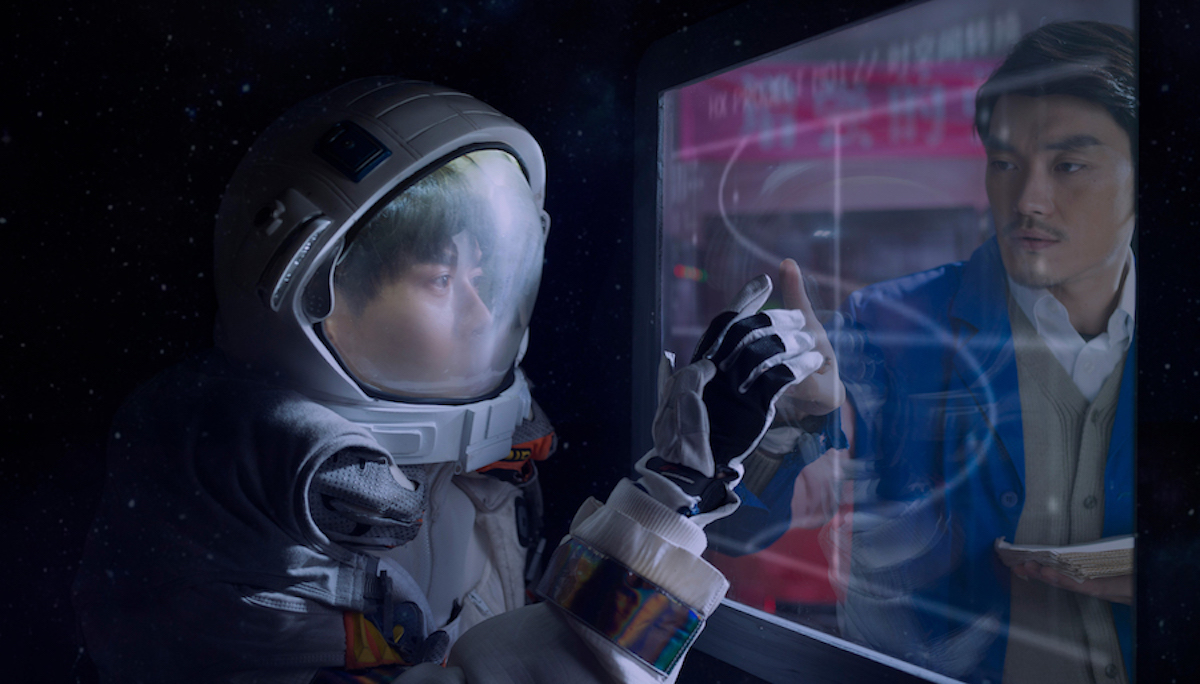Maggi Hambling’s Statue Of ‘Mother Of Feminism’ Mary Wollstonecraft Unveiled
A statue honouring Mary Wollstonecraft the “mother of feminism” by the artist Maggi Hambling finally gets unveiled in north London, after a 10-year campaign.The sculpture will go on display on Newington Green, Islington, from Tuesday 10 November.
Born in London in 1759, Wollstonecraft was an 18th Century English writer, philosopher, and advocate of women’s rights. Until the late 20th century, Wollstonecraft’s life, which encompassed several unconventional personal relationships at the time, received more attention than her writing. Today Wollstonecraft is regarded as one of the founding feminist philosophers, and feminists often cite both her life and her works as important influences.

The silvered-bronze statue has received criticism from some who have queried the inclusion of a naked female figure. Bee Rowlatt, chair of the Mary on the Green campaign for a statue, said: “Her ideas changed the world. It took courage to fight for human rights and education for all.
“But following her early death in childbirth her legacy was buried, in a sustained misogynistic attack. Today we are finally putting this injustice to rights. “It’s not your average memorial statue at all. “It’s not of her, it’s for her, and the statue draws you in. I hope it sparks a conversation about Wollstonecraft and her extraordinary life.”
After a decade of campaigning to raise the £143,000 required to create the statue, a silver female figure emerging from a swirling mingle of female forms. More than 90% of London’s monuments celebrate men, compared to a population of 51% women, according to the campaign.
Wollstonecraft mixed with the intellectual radicals of the day – debating with Benjamin Franklin, Thomas Paine and Joseph Priestley. She died aged 38 following the birth of her daughter.
Maggi Hambling said: “This sculpture encourages a visual conversation with the obstacles Ms Wollstonecraft overcame, the ideals she strived for, and what she made happen. “Clothes define people and restrict people, they restrict people’s reaction. She’s naked and she’s every woman.
“It’s been compared to a rocket of hope going up to the sky, tracking the fight for female empowerment Wollstonecraft started.” The Suffolk-based artist says Wollstonecraft would be “dancing a foxtrot in her grave” to celebrate Kamala Harris becoming the first female US vice president.

Deutsche Börse Photography Foundation Prize 2021 Shortlist Announced
The four artists shortlisted for the Deutsche Börse Photography Foundation Prize 2021 are Poulomi Basu, Alejandro Cartagena, Cao Fei and Zineb Sedira. (Top Photo: Image 4 Cao Fei Nova, 2019 © Cao Fei Courtesy of artist, Vitamin Creative Space and Sprüth Magers)
2021 celebrates the 25th anniversary of this long-standing and prestigious annual prize, which recognizes artists and projects deemed to have made the most significant contribution to photography over the previous 12 months.
The 2021 shortlist presents four highly individual artists, whose bold wide-ranging projects cover geographical territories from Algeria to China and explore issues affecting both the local and the global.
From Poulomi Basu’s uncompromisingly complex depiction of conflict in Central India, Alejandro Cartagena’s scathing critique exploring the repercussions of homeownership and developments in northern Mexico, to Cao Fei’s dystopic multi-media fabrications that consider the enormous impact of technologies on lived experiences and Zineb Sedira’s generous auto-fictive exploration of memory, culture and belonging. All of the nominated projects use photography as a means of challenging political realities to convey subjective truths.
The exhibition of the shortlisted projects, curated by Anna Dannemann, will be on show at The Photographers’ Gallery from 19 March—27 June 2021. The exhibition will also be presented as part of the international photography triennial RAY Fotografieprojekte Frankfurt/RheinMain and will be on display at Deutsche Börse’s headquarters in Eschborn/Frankfurt from 5 June—12 September 2021.
The winner of the £30,000 prize will be announced at an award ceremony in late Spring 2021. Full details will be announced in January 2021.
The Shortlisted Artists and Projects:
Poulomi Basu has been nominated for her book Centralia published by Dewi Lewis Publishing in 2020.
Indian transmedia artist, photographer and activist Poulomi Basu (b. 1983, India) has created a complex and brutally effective body of work that uncovers the violent, mostly unreported, conflict between a marginalized community of indigenous people fighting under the People’s Liberation Guerilla Army (PLGA) and the Indian state. Primarily shot in central India, Centralia is the outcome of a long-term project focused on the region, but also about the limitations of traditional documentary photography to expose the overt and multi-layered reality of contemporary conflicts. Referencing dystopian tropes of science-fiction, Basu destabilizes the conventional linear order of narratives to create nuanced work that allows a view of a future where current events have reached their climax. To this end, Basu uses a multitude of image types; from cinematic double exposures of dark landscapes, staged portraits and sourced image material, to shocking photographs of brutal crime scenes, testimonies and mugshots of fallen, often female, revolutionary fighters alongside images showing the traditional festivities of the rural communities. By carefully orchestrating the juxtapositions of this visual material, Basu’s book reveals the normalization of violence and the mechanisms of conflict from many different perspectives. The project further addresses broader issues of environmental and climate justice, the role of women often battling inequality on multiple fronts and the representation of these conflicts in Western societies.
Alejandro Cartagena has been nominated for his book A Small Guide to Homeownership published by The Velvet Cell in 2020.
In his most recent book, Mexican photographer Alejandro Cartagena (b. 1977, Dominican Republic) continues his extensive visual documentation of the urbanization of land in northern Mexico. The result from over 15 years of work, the project considers idealized notions of life in the suburbs and the enormous impact these dysfunctional developments have had on the surrounding region through transportation links, infrastructure and a cookie-cutter approach to architecture and urban planning. A Small Guide to Homeownership takes its stylistic cues from the ubiquitous How to…? guide books. Printed on thin paper and running to over 300 pages, it encompasses an extensive range of visual material. Utilizing landscape images, advertisements, texts, portraits, city backdrops and documentary photography to create layered collages, Cartagena weaves a complex cautionary tale about the historical, political, public and personal concepts and processes of home-buying in Mexico. The book follows a series of protagonists, such as Cartagena’s brother, illustrating their personal struggles in overcoming bureaucratic challenges to fulfil the propagandized dream of finding their own home. Another important factor is also the influence of the USA and how their approach to urban development and gentrification, adopted by the Mexican Government after the 1960s, has led to the ongoing economic and social divide.
Cao Fei has been nominated for her exhibition Blueprints at Serpentine Gallery, London (4 March—17 May 2020 and reopened after lockdown 4 August—13 September 2020).
Working with film, digital media, photography, sculpture and performance, Chinese artist Cao Fei (b. 1978, Guangzhou, China) has built an extensive body of work over the last two decades that considers how the rapid development of the digital and other technological advancements have radically altered our perception of self and the way we understand and navigate reality. This first major solo exhibition in the UK re-imagined new and existing works in a site-specific installation that included the new VR piece The Eternal Wave and the feature-length science fiction film Nova as well as earlier projects such as Whose Utopia, Asia One and La Town. Cao Fei’s projects often revolve around the effects of automation, virtual realities and hyper urbanization on the human condition, while further addressing issues of memory, history, consumerism and societal structures – particularly in her native China. Creating complex, surreal and often darkly humorous dystopian fictions, Cao Fei’s works scrutinize modern systems of surveillance, production and labour reflecting our relationship with intelligent machines and adding critical commentary about the isolating effect these have on every aspect of individual living. Her moving image works are often set in labyrinthine, industrial, or urban settings where the human body, identity and emotions seem alien or redundant and the impending future full of apocalyptic uncertainty. Yet within these dark, twisted environments, there are also moments of subversion in which her protagonists find ways to use the technology to shape alternative, collective futures.
Zineb Sedira has been nominated for her exhibition A Brief Moment at Jeu de Paume, Paris (15 October 2019 – 19 January 2020).
Zineb Sedira (b. 1963, Paris, France, based in London) works across photography, installation and film to create meaningful immersive projects that tackle the universally resonant themes of identity, mobility, gender and environment. Marking her first major retrospective in Paris, A Brief Moment spans a period from 1998 to the present day and focuses on Sedira’s use of archives to explore the function and impact of images to (re-) construct meaning through a process of collecting and exhibiting. Frequently combining the personal with the globally political, Sedira uses the lens of her family history, closely linked to that of Algiers, France and the UK, to form collective narratives that testify to the experience of people living between different cultures. Sedira’s projects are rich with metaphors and constantly shifting between a layered portrait of the artist and a broader reflection on memory, culture and belonging. The piece Standing Here Wondering Which Way to Go invited visitors into a set of Sedira’s living room as a way of foregrounding the influence of the 1969 Pan-African Festival of Algiers and the revolutionary movements of the 1960s and 1970s. Similar to her video work these personal installations are inspired by the idealism of a multi-cultural world forged in the counterculture movements of this era, juxtaposed against the repercussions of geopolitical and industrial changes that occurred in the later 20th and early 21st century.

Stanley Spencer Gallery Cookham Acquires Last Self-Portrait Of The artist.
Stanley Spencer Gallery acquires final self-portrait drawing of the artist.
The last known self-portrait drawing of Stanley Spencer — executed a few months before his death in 1959 — has been acquired by the gallery dedicated to his work in his hometown, Cookham, Berkshire. The work, which has been purchased with the support of Art Fund on behalf of the Stanley Spencer Gallery, as well as The Band Trust, The V&A Purchase Grant Fund and The Friends of Stanley Spencer Gallery, was conceived as a work in its own right before he painted a version in oil, now owned by Tate Britain.
The drawing is showcased as part of the Stanley Spencer Gallery’s current exhibition, LOVE, ART, LOSS: The Wives of Stanley Spencer at the Stanley Spencer Gallery (until Autumn 2021), which explores the relationship between arguably two of the most influential figures in the artist’s life —his two wives, Hilda Carline and Patricia Preece.
Says a spokesperson for the Stanley Spencer Gallery: This is a critical addition to the Stanley Spencer Gallery, and we are grateful to the generous financial support of the Art Fund on behalf of the Stanley Spencer Gallery, as well as The Band Trust, The V&A Purchase Grant Fund and The Friends of Stanley Spencer Gallery.’

